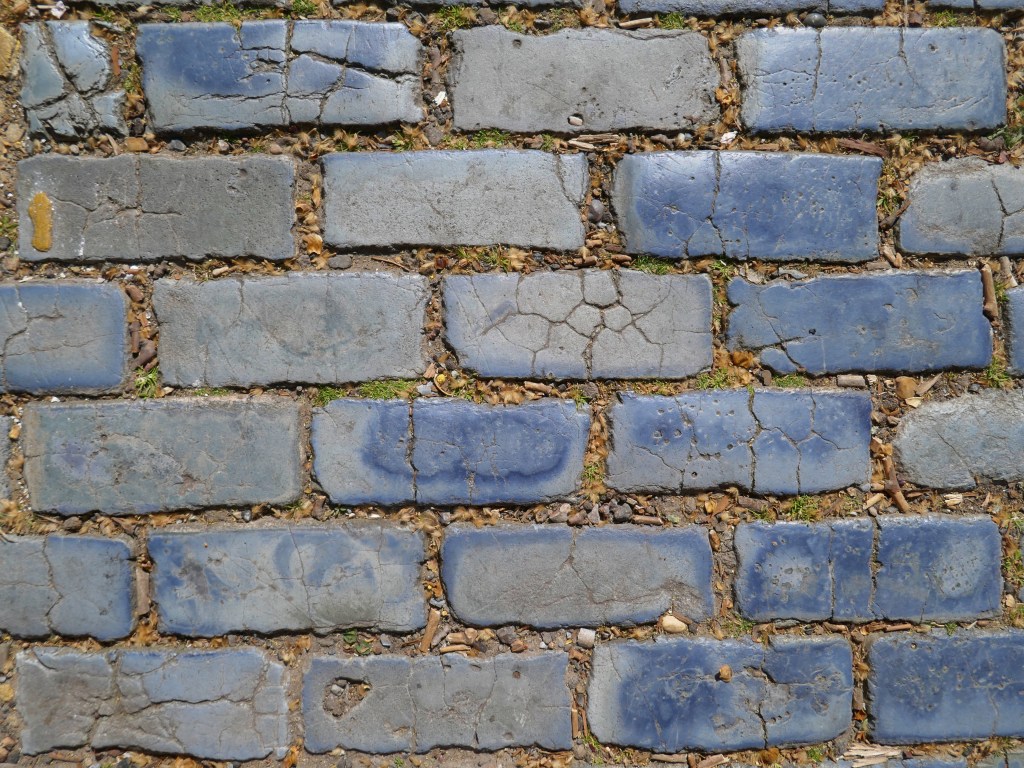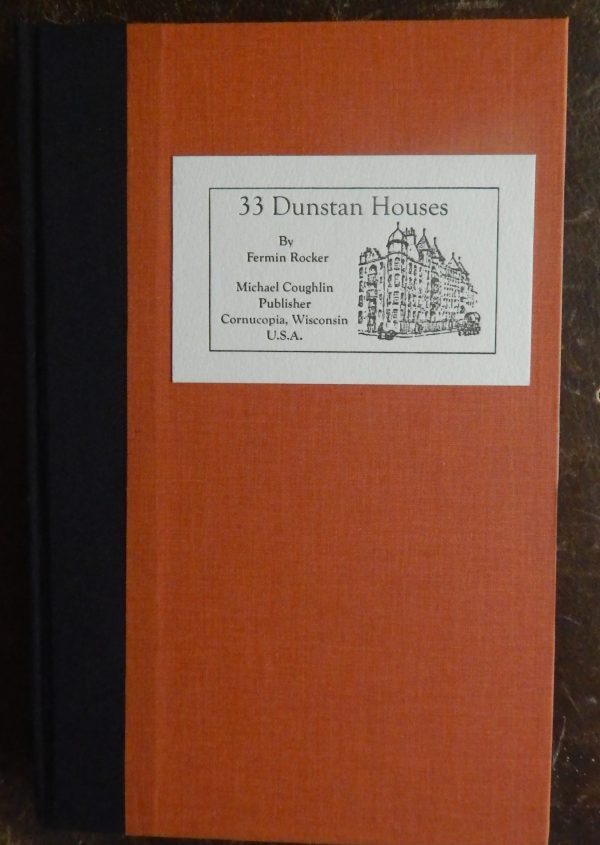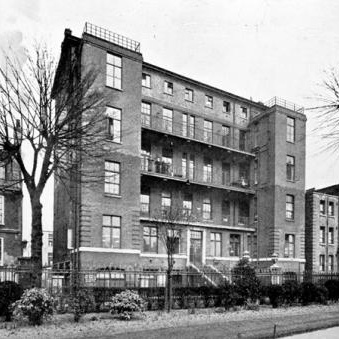
One of my absolute favourite London building material is the shiny blue glazed Scoria Brick of Teeside seen above at Stepney Green.
Scoria bricks are a by-product of the Teeside iron industry and are not clay based like most other bricks. Iron makers were looking for a use for the waste scum or slag from their blast furnaces and a Joseph Woodward came up with an idea. Chris Lloyd in The Northern Echo states “In November 1872, the Darlington man formed the Tees Scoriae Brick Company to turn slag from the Clay Lane Blast Furnace, in Eston, Middlesbrough, into the shiney-blue bricks that now line our lanes.” noting that the word ‘scoria’ “comes from the Greek word meaning ‘excrement or dung’ The Romans applied it to the hot dark lava wastefully tossed from the top of a volcano.” The Victorians preferred scoria even though it’s etymology is of excrement to the word slag! [1]

Scoria bricks were only produced for a few decades as the seminal article on these bricks, by CH Morris, in Number 13 (1981) of The Cleveland Archaeologist, notes that they were first marketed only in 1880 and that production had pretty well stopped by the 1950s.
The Tees Scorriae Brick Company went bankrupt in 1966 and was formally wound up in 1972. “The Tees Scoriae Block Company was finally wound up in July 1966 but the demand for scoria blocks must have been declining for the last 20-30 years of the company ‘s
existence. This is borne out to some extent by the fact that the production of scoria blocks at the Skinningrove Iron Company’s Works was closed in the late 1950s or early 1960s. ” [2]
The Tees Scorriae Brick Company appears to have produced 12 different types of scoria brick. The most common are either plain bricks or the double bricks, which have a dividing line down the middle. The ones at Stepney Green are just plain glazed blocks.
They are misidentified in this post but check the comments for really good clarifications. [3]

Technically Scoria was/is “Iron and steel slag, also known as ferrous slag, … produced by adding limestone (or dolomite), lime and silica sand to blast furnaces and steel furnaces to strip impurities from iron ore, scrap and other ferrous feed materials and to lower the heat requirements of the iron- and steelmaking processes. Ferrous slag forms as a dominantly calcium silicate melt that floats on top of the molten crude iron or steel; the slag is then removed from the liquid metal. ” [4] [5]
So it’s essentially Calcium silicate [6] and Morris notes the proportions as roughly 30-40 % Lime, 30-40 % Silica and c 10% Aluminium and various other minerals. [2]
Henry Fidler in his 1879 edition of Notes on Building Construction Part 3 Materials, Arranged to meet the requirements of the syllabus of the Science & Arts Department of the Committee of Council on Education, South Kensington, says “Slag bricks are made by running molten slag into iron moulds. The blocks are removed while the interior is still molten, and then annealed in ovens.” [7]
For a while scoria bricks was a significant export from Teeside and “... by 1912 exports of scoria blocks from Middlesborough … amounted to 62 ,881 tons of which 37% was shipped to British America [ presumably Canada ] 35 % to the West Indies, 14 % to Holland , 10% to the United States of America and small quantities to India, South America, Belgium and Africa… And a further 1051 tons were carried by the Tyne-Tees Steam Shipping Co Ltd from Middlesbrough to London. ” [2]
It’s pretty unusual to see these blocks/bricks in London and I’ve only noticed them in a few other places: Middlesex Filter Beds, Essex Filter Beds and bizarrely in a road in Barnet!


If you want some see these on sale [8]
When were the ones at Stepney Green put down I wonder? I would think that they went down when the Stepney Green Gardens was opened in the 1870s [ see below ] as that would fit with their production and export from Teeside though a fairly early usage!
Unlike with Watergate Street in Greenwich, I am please to see these blocks seem to have some protection and are acknowledged in the Tower Hamlets Conservation Area statement even though they are not correctly fully described: “Stepney Green … is characterized by the architectural quality of the residential houses and mansions blocks along its edges, and by the picturesque quality created by the mature trees of Stepney Green Gardens and front gardens on the east side. The route has two thoroughfares – the main road along the west side of the gardens and a narrower lane comprised of characterful blue blocks and granite sets on the eastern side of the gardens. … The proper maintenance of this blue cobbled way is important to preserve the character of the Conservation Area.” [9]

I have to say a bit about Stepney Green too. It has a radical history encompassing The Peasants Revolt, The Chartists and early 20thC anarchism! The London Gardens Trust states “Stepney Green Gardens are remnants of Mile End Green, which was the largest of several commons in the Manor of Stepney. The four long narrow strips of garden are the last remaining part of the fields where Richard II met the rebels in the Peasant’s Revolt of 1381. In the late C17th a strip from the northern end to a line at right angles to the large No. 71 letterbox was enclosed and planted with rows of trees to screen several large country houses from the highway. A gravel path was also made, now the narrow roadway along the eastern side of gardens. In 1872 local campaigns to save the long strip of land from developers led to the creation of the four public gardens by the Metropolitan Board of Works….The East End Chartists gathered here on 10 April 1848 to march to a great meeting on Kennington Common. In 1872 local campaigns to save the long strip of land from developers led to the creation of the four public gardens by the Metropolitan Board of Works. The narrow roadway separating the gardens from the houses is paved with Tees Scoriae bricks made in Middlesbrough from slag from local iron furnaces.” [10]
There is a row of 17th and early 18thC houses on the east side including No 37 which was saved by the Spitalfields Trust though later sold into private hands. The ” … magnificent house, … dates from 1694. It is one of the finest in the entire borough, and a rare example of a large, formerly free-standing 17th-century house in inner London. ” [11]

What has always fascinated me most about Stepney Green, apart from it’s Scoria Bricks, was it’s early 20thC occupants German anarchist Rudolf Rocker and his partner in love and politics, Milly Witkop an Ukrainian-born Jewish immigrant, who lived at 33 Dunstan Houses on the western side of Stepney Green. [12] [13] [14]
There is a lot written about Rocker and Witkop political organising including the production of the Yiddish Arbiter Fraint and organising numerous strikes of tailors and bakers. [15] [16] [17] and a great interview and obituary for Fermin Rocker their son who grew up in Dunstan Houses here with Andrew Whitehead [18]
Letterpress have produced a gorgeous looking book that I have not read, also available from AK press. [19] [20]

Also see Fermin Rocker’s ‘The East End years: A Stepney Childhood’ from Freedom Press [21] and Emma Sellers has a fantastic set of biographies of on Writing Lives. [22]

Rudolf Rockers himself has an extraordinary memoir “The London Years” which can be read free on Lib Com. [23] Though he lived at 33 Dunstan Buildings from I think 1900 to his internment in 1914, bizarrely it contains no mention of the Scoria bricks of Stepney Green! 😀 I suppose in between writing, setting and printing the Arbeter Fraint, helping bring up a family AND organising the mass strikes of the tailors and bakers in the Jewish East End he may not have noticed. However I would like to think in a walk across the green to visit an old Jewish anarchist in the Home for Aged Jews at No 37 Stepney Green maybe he would marvelled at and point out the shiny blue bricks to his young son Fermin!

I’m not finished though. I have a direct, though tenuous, family link with these bricks. 😀 My mum as a student doctor worked at The London Jewish in the late 1940s. She would have walked across these bricks every day to get into the hospital. Though if she came on the District Line actually she wouldn’t as she would have come through the east side. The London Jewish closed in the 1970s, it’s patient base having moved away and was knocked down and replaced by a private hospital on the site now. [24] [25] [26]

And my Dad’s link? Well even more tenuous! 😀 But he was born and grew up in Stepney. Well Stebonheath. In Llanelli. But Stebonheath is the old word for Stepney and a branch of the Stepney family, [27] [28] from what was then Stebonheath, in London, went to Llanelli in the 16thC and became very successful. Llanelli has a Stepney Street, Stepney Road, Stepney Place and Stepney Precinct! My dad attended Stebonheath Infants and later, Park Street Boys at the end of Stepney St, where as a teen he would do the Monkey Walk with his friends on Sunday afternoon after hours in chapel and Sunday School! [ ” The one full leisure day, Sunday, was normally spent at home and at chapel or church, with the evening seeing social gatherings, while the teenagers paraded in Sunday best on “the monkey walk”, ] [29] I’m not sure if my parents ever discussed their Stepney connection nor the scoria bricks but I’ll ask!
References:
[1] https://www.thenorthernecho.co.uk/news/3206104.mortar-bricks-meets-eye/
[2] http://cias-teesside.uk/the-cleveland-industrial-archaeologist/
[3] https://charlessaumarezsmith.com/2017/07/22/blue-bricks/
[4] https://www.earthmagazine.org/article/mineral-resource-month-iron-and-steel-slag/
[5] https://en.wikipedia.org/wiki/Slag
[6] https://en.wikipedia.org/wiki/Calcium_silicate
[7] PDF here https://bit.ly/323sSBb
[8] here! http://www.obrien-architectural.com/index.php/reclamation/reclamation/42-reclaimed-bricks-uk/647-scoria-brick.
[9] https://www.towerhamlets.gov.uk/Documents/Planning-and-building-control/Development-control/Conservation-areas/Stepney-GreenV1.pdf
[10] https://londongardenstrust.org/conservation/inventory/site-record/?ID=THM053&sitename=Stepney+Green+Gardens
[11] https://www.thespitalfieldstrust.com/project/37-stepney-green-stepney-london-2/
[12] https://eastendwomensmuseum.org/blog/milly-witkop
[13] https://www.redpepper.org.uk/rudolf-rocker-an-anarchist-rabbi-in-london/
[14] http://sarahjyoung.com/site/2011/01/09/russians-in-london-pyotr-kropotkin/
[15] http://www.solfed.org.uk/da/the-workers-friend-rudolf-rocker-and-the-arbeter-fraint-jewish-anarchist-group-in-the-east-end-of
[16] https://en.wikipedia.org/wiki/Rudolf_Rocker
[17] https://pasttenseblog.wordpress.com/2016/07/15/today-in-london-radical-history-yiddish-anarchist-paper-arbeter-fraint-founded-whitechapel-1885/
[18] http://www.andrewwhitehead.net/political-voices-fermin-rocker.html
[19] https://www.letterpressbookpublishing.com/product/33-dunstan-houses/
[20] https://www.akpress.org/33dunstanhouses.html
[21] https://freedompress.org.uk/product/the-east-end-years-a-stepney-childhood/
[22] http://www.writinglives.org/category/fermin-rocker
[23] https://libcom.org/files/Rudolf%20Rocker%20-%20The%20London%20Years.pdf
[24] https://ezitis.myzen.co.uk/londonjewish.html
[25] https://jewishmuseum.org.uk/2019/05/09/anniversary-of-the-london-jewish-hospital/
[26] https://www.jewsfww.uk/london-jewish-hospital-271.php
[27] https://en.wikipedia.org/wiki/Stepney_family
[28] http://www.mernick.org.uk/thhol/stepney1.html
[29] http://www.culturalecology.info/baywatch/baywatch1/lac1/baywtch4/projects/people/morgan.htm
Leave a reply to Building London 1-50 index – Building London – what London is made from and where it came from! Cancel reply